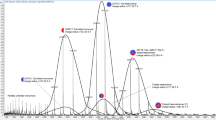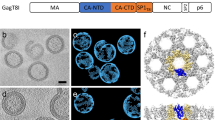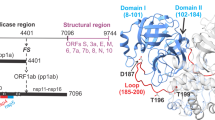Abstract
HIV-1 protease processes the Gag and Gag-Pol polyproteins into mature structural and functional proteins, including itself, and is therefore indispensable for viral maturation1,2. The mature protease is active only as a dimer3,4,5 with each subunit contributing catalytic residues6. The full-length transframe region protease precursor appears to be monomeric yet undergoes maturation via intramolecular cleavage of a putative precursor dimer5,7,8,9,10,11, concomitant with the appearance of mature-like catalytic activity7,9. How such intramolecular cleavage can occur when the amino and carboxy termini of the mature protease are part of an intersubunit β-sheet located distal from the active site is unclear. Here we visualize the early events in N-terminal autoprocessing using an inactive mini-precursor with a four-residue N-terminal extension that mimics the transframe region protease precursor5,12. Using paramagnetic relaxation enhancement, a technique that is exquisitely sensitive to the presence of minor species13,14,15,16, we show that the mini-precursor forms highly transient, lowly populated (3–5%) dimeric encounter complexes that involve the mature dimer interface but occupy a wide range of subunit orientations relative to the mature dimer. Furthermore, the occupancy of the mature dimer configuration constitutes a very small fraction of the self-associated species (accounting for the very low enzymatic activity of the protease precursor), and the N-terminal extension makes transient intra- and intersubunit contacts with the substrate binding site and is therefore available for autocleavage when the correct dimer orientation is sampled within the encounter complex ensemble.
This is a preview of subscription content, access via your institution
Access options
Subscribe to this journal
Receive 51 print issues and online access
$199.00 per year
only $3.90 per issue
Buy this article
- Purchase on Springer Link
- Instant access to full article PDF
Prices may be subject to local taxes which are calculated during checkout



Similar content being viewed by others
Change history
14 November 2008
In the online-only extended Methods, a sentence in the second paragraph of the 'NMR experiments' section has been corrected.
References
Louis, J. M., Weber, I. T., Tozser, J., Clore, G. M. & Gronenborn, A. M. HIV-1 protease: maturation, enzyme specificity, and drug resistance. Adv. Pharmacol. 49, 111–146 (2000)
Louis, J. M., Ishima, R., Torchia, D. A. & Weber, I. T. HIV-1 protease: structure, dynamics and inhibition. Adv. Pharmacol. 55, 261–298 (2007)
Wlodawer, A. & Erikson, J. Structure-based inhibitors of HIV-1 protease. Annu. Rev. Biochem. 62, 543–585 (1993)
Wlodawer, A. & Vondrasek, J. Inhibitors of HIV-1 protease: a major success of structure-assisted drug design. Annu. Rev. Biophys. Biomol. Struct. 27, 249–284 (1998)
Ishima, R., Torchia, D. A., Lynch, S. M., Gronenborn, A. M. & Louis, J. M. Solution structure of the mature HIV-1 protease monomer: insight into the tertiary fold and stability of a precursor. J. Biol. Chem. 278, 43311–43319 (2003)
Miller, M. et al. Conserved folding in retroviral proteases: crystal structure of a synthetic HIV-1 protease. Science 246, 1149–1152 (1989)
Louis, J. M., Nashed, N. T., Parris, K. D., Kimmel, A. R. & Jerina, D. M. Kinetics and mechanism of autoprocessing of human immunodeficiency virus type 1 protease from an analog of the Gag-Pol polyprotein. Proc. Natl Acad. Sci. USA 91, 7970–7974 (1994)
Co, E. et al. Proteolytic processing mechanisms of a miniprecursor of the aspartic protease of human immunodeficiency virus type 1. Biochemistry 33, 1248–1254 (1994)
Louis, J. M., Wondrak, E. M., Kimmel, A. R., Wingfield, P. T. & Nashed, N. T. Proteolytic processing of HIV-1 protease precursor, kinetics and mechanism. J. Biol. Chem. 274, 23437–23442 (1999)
Louis, J. M., Clore, G. M. & Gronenborn, A. M. Autoprocessing of HIV-1 protease is tightly coupled to protein folding. Nature Struct. Biol. 6, 868–874 (1999)
Pettit, S. C., Everitt, L. E., Choudhury, S., Dunn, B. M. & Kaplan, A. H. Initial cleavage of the human immunodeficiency virus type 1 GagPol precursor by its activated protease occurs by an intramolecular mechanism. J. Virol. 78, 8477–8485 (2004)
Ishima, R., Torchia, D. A. & Louis, J. M. Mutational and structural studies aimed at characterizing the monomer of HIV-1 protease and its precursor. J. Biol. Chem. 282, 17190–17199 (2007)
Iwahara, J. & Clore, G. M. Detecting transient intermediates in macromolecular binding by paramagnetic NMR. Nature 440, 1227–1230 (2006)
Tang, C., Iwahara, J. & Clore, G. M. Visualization of transient encounter complexes in protein-protein association. Nature 444, 383–386 (2006)
Volkov, A. N., Worall, J. A., Holtzmann, E. & Ubbink, M. Solution structure and dynamics of the complex between cytochrome c and cytochrome c peroxidase determined by paramagnetic NMR. Proc. Natl Acad. Sci. USA 103, 18945–18950 (2006)
Tang, C., Schwieters, C. D. & Clore, G. M. Open-to-closed transition in apo maltose-binding protein observed by paramagnetic NMR. Nature 449, 1078–1082 (2007)
Tessmer, U. & Kräusslich, H.-G. Cleavage of human immunodeficiency virus type 1 proteinase from the N-terminally adjacent p6* protein is essential for efficient Gag polyprotein processing and viral infectivity. J. Virol. 72, 3459–3463 (1998)
Ludwig, C., Leiherer, A. & Wagner, G. Importance of protease cleavage sites within and flanking human immunodeficiency virus type 1 transframe protein p6* for spatiotemporal regulation of protease activation. J. Virol. 82, 4573–4584 (2008)
Wondrak, E. M., Nashed, N. T., Haber, M. T., Jerina, D. M. & Louis, J. M. A transient precursor of the HIV-1 protease: isolation, characterization and kinetics of maturation. J. Biol. Chem. 271, 4477–4481 (1996)
Cherry, E. et al. Characterization of human immunodeficiency virus type-1 (HIV-1) particles that express protease-reverse transcriptase fusion proteins. J. Mol. Biol. 284, 43–56 (1998)
Iwahara, J., Tang, C. & Clore, G. M. Practical aspects of 1H transverse paramagnetic relaxation enhancement measurements on macromolecules. J. Magn. Reson. 184, 185–195 (2007)
Schwieters, C. D., Kuszewski, J. & Clore, G. M. Using Xplor-NIH for NMR molecular structure determination. Prog. Nucl. Magn. Reson. Spectrosc. 48, 47–62 (2006)
Iwahara, J., Schwieters, C. D. & Clore, G. M. Ensemble approach for NMR structure refinement against 1H paramagnetic relaxation enhancement data arising from a flexible paramagnetic group attached to a macromolecule. J. Am. Chem. Soc. 126, 5879–5896 (2004)
Spinelli, S., Liu, Q. Z., Alzari, P. M., Hirel, P. H. & Poljak, R. J. The three-dimensional structure of the aspartyl protease from the HIV-1 isolate BRU. Biochimie 73, 1391–1396 (1991)
Schwieters, C. D. & Clore, G. M. Reweighted atomic densities to represent ensembles of NMR structures. J. Biomol. NMR 23, 221–225 (2002)
Wondrak, E. M. & Louis, J. M. Influence of flanking sequences on the dimer stability of human immunodeficiency virus type 1 protease. Biochemistry 35, 12957–12962 (1996)
Mahalingam, B. et al. Crystal structures of HIV protease V82A and L90M mutants reveal changes in the indinavir-binding site. Eur. J. Biochem. 271, 1516–1524 (2004)
Altieri, A. S., Hinton, D. P. & Byrd, R. A. Association of biomolecular systems via pulsed field gradient NMR self-diffusion measurements. J. Am. Chem. Soc. 117, 7566–7567 (1995)
Chou, J. J., Baber, J. L. & Bax, A. Characterization of phospholipid mixed micelles by translational diffusion. J. Biomol. NMR 29, 299–308 (2004)
Grzesiek, S. & Bax, A. The importance of not saturating H2O in protein NMR: application to sensitivity enhancement and NOE measurements. J. Am. Chem. Soc. 115, 12593–12594 (1993)
Clore, G. M. & Gronenborn, A. M. Two-, three- and four-dimensional NMR methods for obtaining larger and more precise three-dimensional structures of proteins in solution. Annu. Rev. Biophys. Biophys. Chem. 20, 29–63 (1991)
Clore, G. M. & Gronenborn, A. M. Multidimensional heteronuclear nuclear magnetic resonance of proteins. Methods Enzymol. 239, 349–363 (1994)
Grzesiek, S., Stahl, S. J., Wingfield, P. T. & Bax, A. The CD4 determinant of downregulation by HIV-1 Nef directly binds to Nef: mapping of the Nef binding surface by NMR. Biochemistry 35, 10256–10261 (1996)
Wishart, D. S. & Sykes, B. D. The 13C chemical-shift index: a simple method for the identification of protein secondary structure using 13C chemical-shift data. J. Biomol. NMR 4, 171–180 (1994)
Shen, Y. et al. Consistent blind protein structure generation from NMR chemical shift data. Proc. Natl Acad. Sci. USA 105, 4685–4690 (2008)
Katoh, E. et al. A solution NMR study of the binding kinetics and internal dynamics of an HIV-1 protease-substrate complex. Protein Sci. 12, 1376–1385 (2003)
Clore, G. M. & Kuszewski, J. χ1 rotamer populations and angles of mobile surface side chains are accurately predicted by a torsion angle database potential of mean force. J. Am. Chem. Soc. 124, 2866–2867 (2002)
Kuszewski, J., Gronenborn, A. M. & Clore, G. M. Improving the packing and accuracy of NMR structures with a pseudopotential for the radius of gyration. J. Am. Chem. Soc. 121, 2337–2338 (1999)
Tang, C., Ghirlando, R. & Clore, G. M. Visualization of transient ultra-weak protein self-association in solution using paramagnetic relaxation enhancement. J. Am. Chem. Soc. 130, 4048–4056 (2008)
Kim, Y. C., Tang, C., Clore, G. M. & Hummer, G. Replica exchange simulations of transient encounter complexes in protein-protein association. Proc. Natl Acad. Sci. USA 105, 12855–12860 (2008)
Acknowledgements
We thank R. Ishima for providing initial backbone assignments for the SFNFPR(D25N) protease construct; C. Schwieters for many discussions; Y. Sheng for help with the CS-Rosetta calculations; Y. Kim for providing the code for structure clustering and d.r.m.s. calculations; and J. Sayer for MALDI measurements. This work was supported by funds from the Intramural Program of the NIH, NIDDK and the AIDS Targeted Antiviral program of the Office of the Director of the NIH (to G.M.C.).
Author information
Authors and Affiliations
Corresponding author
Supplementary information
Supplementary Information
This file contains Supplementary Figures and Legends S1-S3 and Supplementary Table S1 In the original Supplementary Fig. 1d, the values of the translational diffusion coefficients (Ds) for the monomeric precursor and mature HIV-1 protease dimer were inadvertently transposed; these have now been corrected. (PDF 287 kb)
Rights and permissions
About this article
Cite this article
Tang, C., Louis, J., Aniana, A. et al. Visualizing transient events in amino-terminal autoprocessing of HIV-1 protease. Nature 455, 693–696 (2008). https://doi.org/10.1038/nature07342
Received:
Accepted:
Issue Date:
DOI: https://doi.org/10.1038/nature07342
This article is cited by
-
HIV-1 protease with leucine zipper fused at N-terminus exhibits enhanced linker amino acid-dependent activity
Retrovirology (2018)
-
Inhibition of the precursor and mature forms of HIV-1 protease as a tool for drug evaluation
Scientific Reports (2018)
-
Multiple frequency saturation pulses reduce CEST acquisition time for quantifying conformational exchange in biomolecules
Journal of Biomolecular NMR (2018)
-
Weak self-association of cytochrome c peroxidase molecules observed by paramagnetic NMR
Journal of Biomolecular NMR (2016)
-
HIV-1 protease cleaves the serine-threonine kinases RIPK1 and RIPK2
Retrovirology (2015)
Comments
By submitting a comment you agree to abide by our Terms and Community Guidelines. If you find something abusive or that does not comply with our terms or guidelines please flag it as inappropriate.



